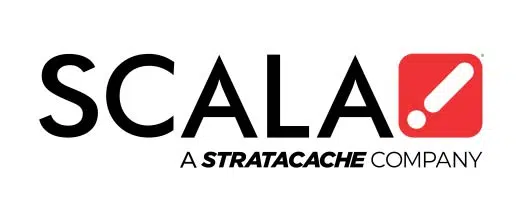FREQUENTLY ASKED QUESTIONS
Quick Answers to Your Digital Signage FAQ Questions!
Frequently Asked Questions
Quick Answers to Your Digital Signage Questions!
Digital Signage Basics
What is digital signage?
How does digital signage work?
Why should I use digital signage for my businesses?
- Higher Customer Engagement
Dynamic and interactive content can help capture your customer’s attention. Any business can capture the attention of customers through visually stunning content. - Better Marketing Activations
Marketing communications can be more effective with digital signage as this can help content management efficiency, deliver targeted messages to specific audiences and real-time date for relevant information all the time. - Real-Time Updates and Flexibility
Digital signage can allow businesses to update changes faster with real-time content and scheduling with Scala Content Manager. - Reduced Printing Costs
Businesses can significantly cut down on printing costs as digital signage is more cost-effective vs traditional static or printed signages. - Analytics and Insights
Businesses can get valuable data with the interactive features of digital signage. - Environmental-friendly and sustainable
LED technology used in digital signages helps showcase high quality content but with energy efficient screens. This creates a more sustainable practice and a better alternative to traditional signage, significantly reducing paper and ink usage.
What types of digital signage displays are available?
- Interactive Kiosks
These are units that are mounted individually. It allows users to interact with the touchscreen display for a more engaging experience. One of the most popular choices today, across all industries. One example are interactive kiosks in malls where customers can locate a store they are looking for in a more engaging experience. This makes transactions more convenient plus in a user-friendly manner. - Video Walls
In high traffic areas, there are usually multiple screens piled up together to create a large high impact area. This can be seen in airports to display schedules, office lobbies to grab attention and showcase immersive messaging and advertising. - Digital Menu Boards
These are used to display menu items, prices, and promotions in restaurants. They offer a flexible and convenient way to update content with high-quality videos or images. It can also be used to upsell based on customer preferences. - Outdoor Digital Signage
For public spaces that are outdoors, such as electronic billboards, these types of digital signage are made with durable materials to survive different weather conditions.
How Can Digital Signage Be Implemented Across Sectors?
- Retail: Self Help Kiosks or Self Check-Out Kiosks
Customers can self-pay by simply scanning and using their debit or credit cards. This improves the decision making for the customer and enhances their experience with the quicker way to shop. Studies show that implementing self-checkout solutions can increase customer satisfaction and reduce labour costs. - Quick Service Restaurants: Self-Order and Payment Kiosks
Quick service restaurants (QSRs) are using self-order and payment kiosks to make the ordering process faster. Customers can choose their own options and pay on their own. This speeds up the service and also increases average order values. - Transportation: Real-Time Schedule Displays
Passengers need to know real-time schedules at ferry terminals, bus stops, train stations, and airports. With the help of digital displays, passengers can find the correct gates, arrival or departure times and stay updated for any delays. This helps improve overall customer satisfaction. - Healthcare: Patient Check-In and Appointment Scheduling, Wayfinding, Hospital Directory, Queue Management, Health Advisories
In medical facilities, patients can be at ease with digital signages that can display waiting times through a queue management system and streamlines the waiting process while improving overall patient flow. Navigation will also be easier with a wayfinding kiosk that can be deployed at entrance areas so patients can easily find their way to the clinics. - Banking and Finance: Secure Queue Management Systems
For the finance and banking sector, queue management systems allow customers to see waiting times, real-time foreign exchange rates, and other relevant information. This improves the customer experience and improves overall efficiency. - Entertainment: Interactive Maps
Theme parks, malls, concert halls or any entertainment venues can deploy interactive digital maps to help visitors navigate the big space and find their way easily. These interactive maps that are displayed on digital screens help provide real-time information about attractions, dining options, and event schedules. - Government: Public Service Inquiries
For government offices or agencies to efficiently display information on public services such as processes on license renewals, permits or community events, they can utilise the use of digital signage solutions and queue management systems that can ease wait times and manage expectations of their visitors. Digital displays can also help answer frequently asked questions and direct visitors to the correct resources for improved operational efficiency. - Hospitality: Self Check-In/Out Process
The self check-in or check-out kiosk and the in-room ordering solution helps give guests a great first impression and instantly quicken processes. These solutions allow guests to check-in or out on their own and even order their meals via an interactive tablet in the comforts of their room.
Where can I implement digital signage?
Digital Signage Content Creation and Management Questions:
How do I create content for digital signage?
What can I display on digital signage?
How often should I update the content on my digital signage?
What are the best practices for digital signage content?
- Create Clear Goals and Objectives
- Craft a Content Strategy
- Design Content for Easy Accessibility and Visibility
- Optimise Display for the Applicable Viewing Environment
- Incorporate Eye-Catching Visuals Effectively
- Regularly Update Content
- Invest in Scala Technical Consulting for Digital Signage Solutions
How can I schedule and manage content on my digital signage network?
Who can upload or change my digital content?
Are there restrictions to the type of content I can display?
Digital Signage Technical Questions:
What are the requirements to set up digital signage?
- Display Screens: Consider your business requirements like size, brightness, resolution, or orientation.
- Media Players: Choose one with the right processing power and storage for your content to play without downtime. Scala offers reliable media players for every business.
- Mounts and Enclosures: Outdoor screens need the right weatherproof enclosures to keep digital screens safe. Always ensure safety first when installing digital screens in locations by using the correct mounts or enclosures.
- Cables:There are different cables for digital displays such as HDMI, Ethernet, and power cables that should be in the correct place to connect components.
Software and Network
- Digital Signage Software: Select a user-friendly content management system (CMS). Scala’s CMS allows remote access to create, schedule, manage and publish content across multiple screens.
- Reliable Internet Connection: Stable and fast internet connection is required to be able to do remote management, content updates and streaming dynamic content such as social media feeds.
- Network Infrastructure: Since this is quite technical, it’s best to ask for assistance from Scala Technical Consulting to create a stable network infrastructure with the correct bandwidth that can support the digital signage network. Several factors that should be considered are scalability, availability and maintainability.
Digital Signage Installation and Configuration
- Location of Screen: Choosing the best placement for the digital screen is crucial in ensuring the best visibility for the target audience avoiding any obstructions.
- Mounting: Make sure that the mount is at a level that can support the weight of the digital screen. A stud finder can be used to securely mount the screens on the wall.
- Properly Connected: Manage cable wires by neatly placing and connecting it to media players, power sources, and digital screens.
- Configuration: To set up playlists, schedules, or display ones, digital signage software should be configured properly. This makes sure that remote management is done efficiently.
- Testing: Conduct testing before launching any digital signage to ensure all functions are working before implementing it publicly.
What software is needed for digital signage?
To make a digital display work properly, a digital signage software just like Scala’s CMS is required as the central application for content management. A digital signage CMS have key features that include:
- Content library and template design tools
- Content scheduling
- Content updates for different digital signage locations, which can be done remotely
- Easy Integration with other systems (e.g., social media, data feeds)
- Data analytics tools to track the performance of displayed content
To get a seamless integration for your digital signage software, consider the following reliable options:
- Scala CMS
- Scala Designer
- Scala Player
How do I integrate digital signage with existing systems?
- Compatibility Assessment – Before choosing, it is best to check if your software and hardware are compatible.
- Integration Planning – Before integration, make sure there are backups in place and the right people who will do the integration to avoid any data loss.
- Smooth Implementation – The digital signage software should be properly set up with playlists, schedules, display zones that are based on the integration requirements.
Can digital signage be used outdoors?
How can the digital signage systems be maintained and how can I troubleshoot the digital signage systems?
- Schedule regular software updates for hardware and software
- Utilise support systems – When selecting a digital signage hardware or software supplier, ensure that they offer the right support for the team when issues arise. Its best to choose providers that are easily contacted or have local offices in Australia such as Scala, this will help you resolve any challenges that may arise.
For proper digital display maintenance, Scala offers an annual maintenance license to ensure that digital signages are always optimised.
What is Digital Signage Hardware?
- Digital screens (LED, LCD, OLED, projectors)
- Media players to store and play content
- Mounts and enclosures to secure the digital displays
- Network components (routers, cables) for connecting the systems
- Sensors and interactive devices for touch screens and other interactive elements
Why do I need a Digital Signage Media Player?
A digital signage will not work effectively without a digital signage media player as the content and data is stored here. You can purchase a cms as a standalone unit or it can be built in then connected to the digital signage CMS. Some of its features include:
- Compatibility with media formats (e.g. videos, images, HTML)
- Network connectivity for remote updates
- Content scheduling
- Data analytics to track engagement and performance
Can I use the existing screens that I have?
What type of media formats does digital signage support?
Images
- JPG, PNG, GIF, BMP
Videos
- MPEG2, H.264, H.265, MP4, AVI
Audio
- MP3, WAV, WMA, AAC
Web Content
- HTML, CSS, JavaScript
- RSS feeds, Twitter, Facebook
- Live web pages
Interactive Content
- HTML5 animations and widgets
- Touchscreen interactivity
- QR codes, NFC, Bluetooth
What is the Installation Process for a Digital Signage?
- Start with choosing the optimal location for the digital signage displays. The location should be visible, close to power sources, and network connections.
- The second step is mounting the digital signage on a secure location using the proper brackets and mounts.
- After the digital signage display is installed, it needs to be plugged to a power source and the digital signage media player.
- The next step is to configure the digital signage software or Scala’s CMS to be able to set up content playlist, schedules or display zones.
- After all these steps, the next step is to test the entire digital signage network and ensure that all parts are properly connected, and the content is playing without interruptions.
What system support should I expect?
Digital Signage Security and Compliance
What can I do to ensure my digital signage is secure?
How can I ensure my digital signage network is private?
Are there regulations for digital signage?
How can it be compliant with local laws?
- You get proper consent from individuals before collecting any personal data.
- Inform users on the purpose of data collection and their rights regarding the data.
- Reinforce data minimisation practices. Collect data that is only necessary for your objectives.
- Schedule reviews on compliance policies in line with legal requirements.
How can I secure a digital signage network?
- Implement strict authentication mechanisms and restrict user access based on roles.
- Use encryption for data and storage to protect critical and sensitive data.
- Consistent Updates on software and firmware.
- Create hardware features like proper enclosures or surveillance. This will help prevent tampering.









